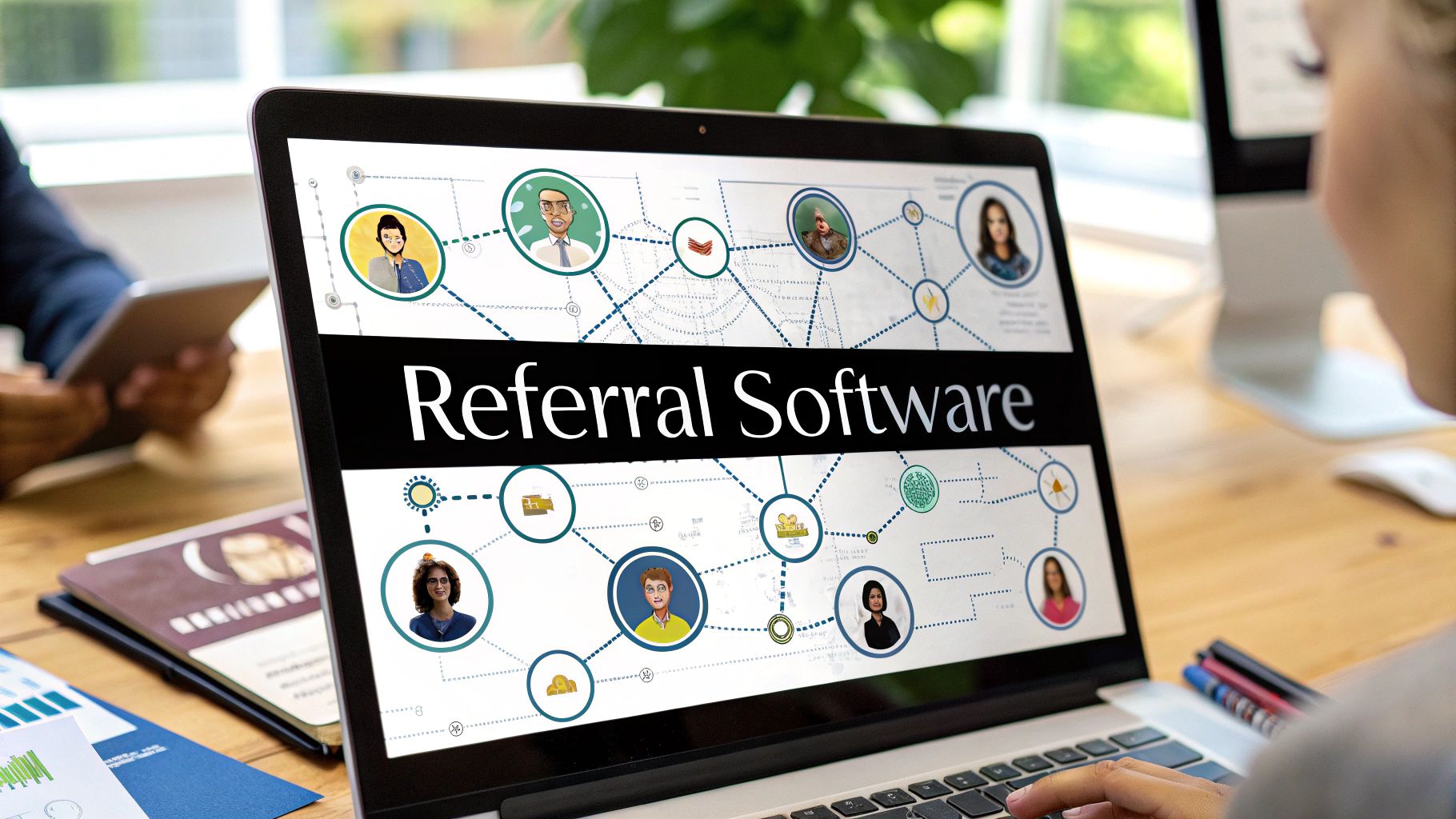Let’s cut to the chase: referral tracking software is a tool that automates the entire process of managing, tracking, and rewarding customer referrals. Think of it as the central command for turning your happiest customers into a well-organized, highly motivated sales team—all without the headaches of manual spreadsheets and endless guesswork.
What Is Referral Tracking Software Anyway?
Imagine you know your customers are talking about you. That's fantastic! But without a system, it's like trying to catch the wind. You have no idea who is sending new business your way, which of those referrals actually become customers, or how to properly thank the people driving that growth.
Referral tracking software steps in to organize that chaos. It transforms those casual, one-off recommendations into a structured, measurable, and predictable engine for growth.
At its heart, this software is a specialized platform for managing word-of-mouth marketing. It gives you the same level of control and insight that you'd expect from any effective marketing campaign tracking system, providing the backbone to run a formal referral program without the administrative nightmare.
From Manual Mess to Automated Success
Before these tools existed, "managing" referrals meant drowning in a sea of spreadsheets, email threads, and sticky notes. It was an absolute mess—time-consuming, riddled with errors, and impossible to scale beyond a handful of people.
Dedicated referral software solves these exact problems.
A core goal here is to create a "closed-loop process." This simply means that every single referral is tracked from the moment it's made all the way to the final sale and reward payout. Nothing and no one falls through the cracks.
This level of automation is what makes a modern referral program not just possible, but profitable. The market growth proves it. The global referral tracking software market was valued at USD 1.2 billion and is expected to rocket to USD 3.5 billion by 2033, growing at a 14.5% compound annual rate. This isn't just a niche tool anymore; it's becoming a fundamental part of the growth toolkit for businesses.
The image below gives you a great visual of how this software connects all the dots.
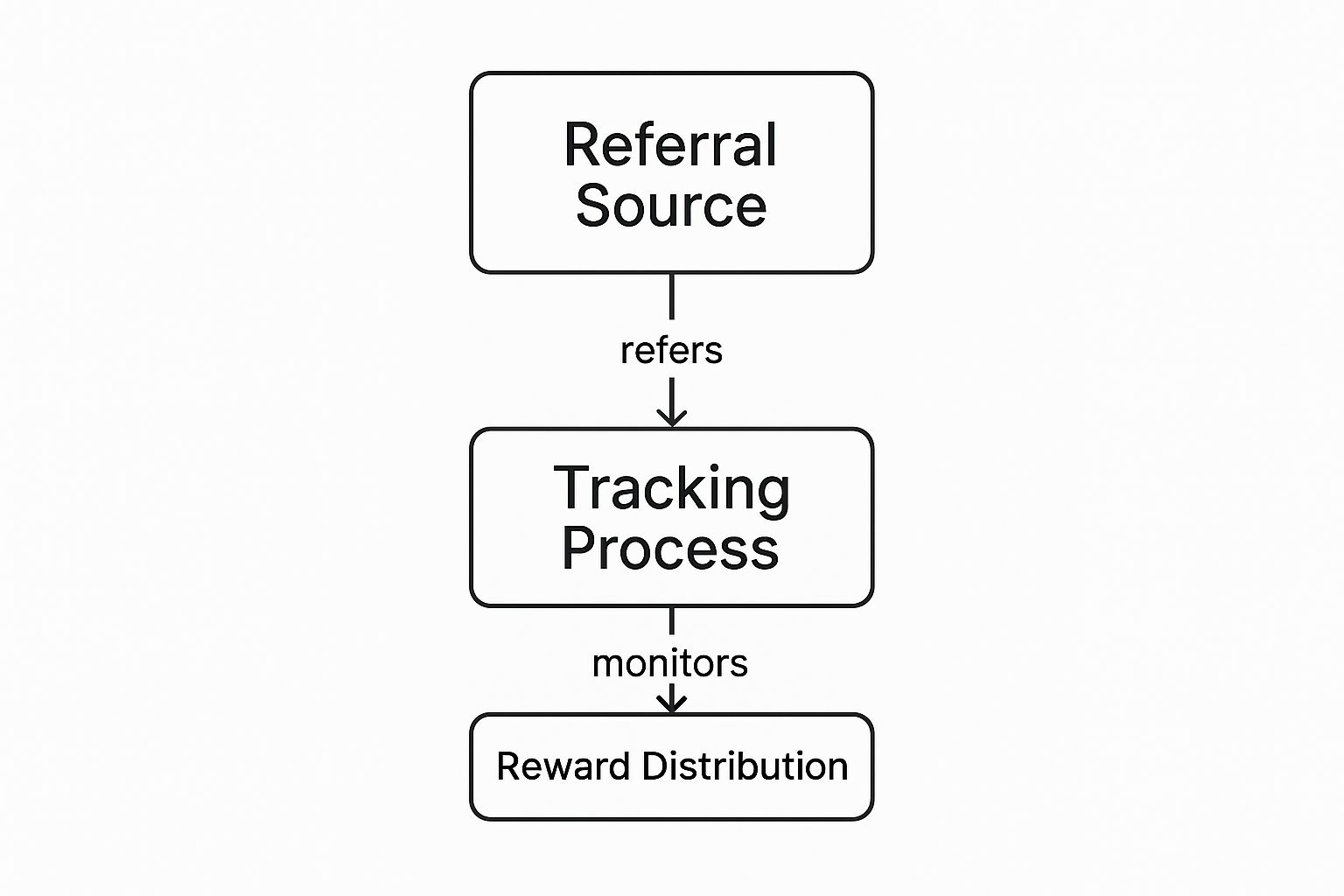
As you can see, the software creates a simple, repeatable cycle. It starts with the advocate sharing, moves through automated tracking, and ends with a seamless reward.
To truly grasp the difference this makes, let’s look at what the software handles for you versus the old, painful manual way.
Core Functions of Referral Tracking Software
This table breaks down the essential tasks automated by referral tracking software, contrasting them with the manual methods they replace.
| Core Function | How Software Automates It | Manual Alternative (Without Software) |
|---|---|---|
| Advocate Onboarding | Instantly generates unique referral links or codes for every customer who joins. | Manually creating and emailing individual discount codes one by one. |
| Referral Attribution | Automatically connects a new customer to the person who referred them via tracking links or codes. | Asking every new customer, "How did you hear about us?" and hoping they remember. |
| Reward Fulfillment | Issues rewards (like store credit, cash, or discounts) automatically as soon as a referral is verified. | Manually cross-checking sales records, then mailing gift cards or applying credits by hand. |
| Performance Analytics | Delivers a real-time dashboard showing your most important metrics—shares, clicks, conversions, and ROI. | Spending hours trying to piece together data from a messy, incomplete spreadsheet. |
Ultimately, this isn't just a tool for handing out rewards. It’s a strategic platform for turning your most passionate customers into a powerful, measurable, and highly effective channel for acquiring new business. It gives you the hard data you need to prove your program's value and make it even better over time.
What to Look For: Key Features of Modern Referral Platforms
Today’s referral tracking software is a far cry from a basic link generator. It’s a complete system built to make launching and managing a program feel effortless for you and completely natural for your customers. Every feature is designed to solve a real-world problem, all working together to transform word-of-mouth into a reliable growth engine.
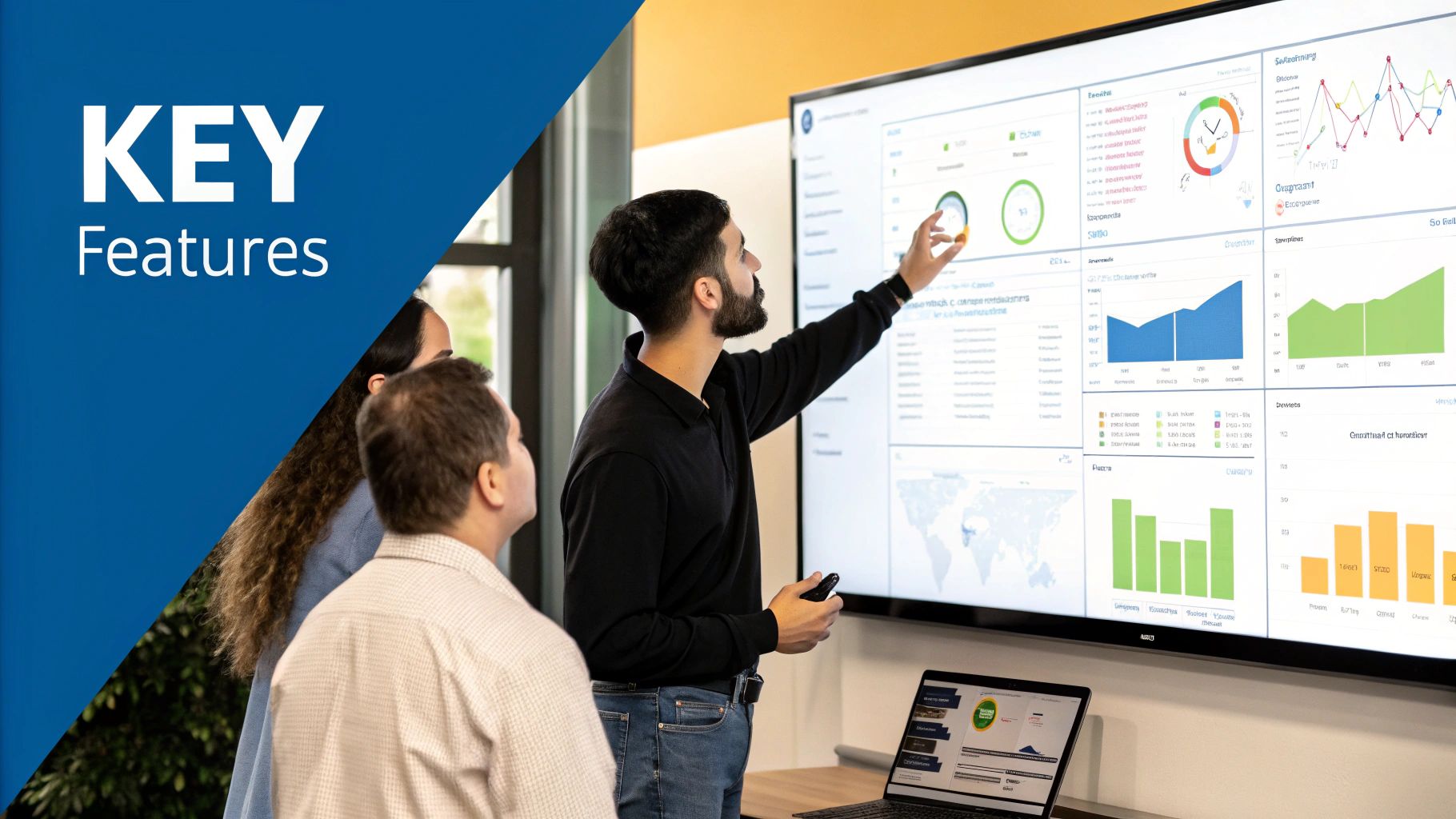
Think of it like the cockpit of an airplane. You don’t need to be an engineer to fly it, but you definitely need to know what the key controls do to get you off the ground and safely to your destination. Let's walk through the core components that power any truly successful referral program.
Unique Referral Links and Codes
At the very core of any referral platform is the ability to create unique referral links or codes for each and every person who signs up to share. This is the non-negotiable foundation that makes accurate attribution possible. When a friend clicks that special link or enters a code, the software knows instantly who to thank.
This one feature completely gets rid of the old "how did you hear about us?" guessing game. It replaces unreliable survey fields with hard, undeniable data, creating a clear line from your advocate to the new customer and, finally, to the reward.
Customizable Dashboards and Analytics
If unique links are the engine, the dashboard is your control panel. A good platform gives you a clean, real-time look at how your program is doing without needing a data scientist to interpret it. This isn't just about watching numbers go up; it's about getting insights you can act on.
At a minimum, you should be able to track these key metrics easily:
- Participation Rate: How many of your customers are actually joining the program?
- Share Rate: Are people actively sharing their links, and how often?
- Click-Through Rate (CTR): Of all the shares, how many are generating clicks?
- Conversion Rate: The most important one—how many of those clicks turn into actual sales or signups?
- Top Advocates: Who are your power users? You need to know who your best referrers are.
This data helps you spot what’s resonating with your audience, celebrate your best brand fans, and calculate the real ROI of your referral marketing.
Automated Reward Fulfillment
Let's be honest: manually tracking who earned what reward is a logistical nightmare. It’s tedious, prone to error, and simply doesn't scale. This is where referral tracking software truly earns its keep. Automation takes this entire burden off your shoulders.
You set the rules—for instance, "Give a $20 gift card 14 days after a new customer's first purchase"—and the system handles the rest. It ensures rewards are delivered on time, every time, without you lifting a finger.
This isn’t just a time-saver; it’s a trust-builder. When your advocates see that they’re rewarded promptly and accurately, they’re much more likely to keep sharing. It keeps the whole program humming along.
Multi-Channel Sharing and Mobile Optimization
Your customers don’t live in one place online, and your referral program shouldn’t either. Great software makes it incredibly easy for advocates to share their links with one or two clicks across all the channels they already use.
Look for built-in sharing options for:
- Social media (Facebook, X, LinkedIn, etc.)
- Direct messaging apps (WhatsApp, Messenger)
- A simple copy-paste option for everything else
Here’s the critical part: this all has to work flawlessly on a smartphone. With nearly 65% of all referrals now happening on mobile devices, a clunky mobile experience will absolutely kill your program's potential. A smooth, intuitive mobile journey isn't just a nice-to-have anymore; it’s a table-stakes requirement to connect with most of your audience. You can see how central this is by looking at trends in the referral marketing software market.
Unlock Strategic Growth with Referral Tracking
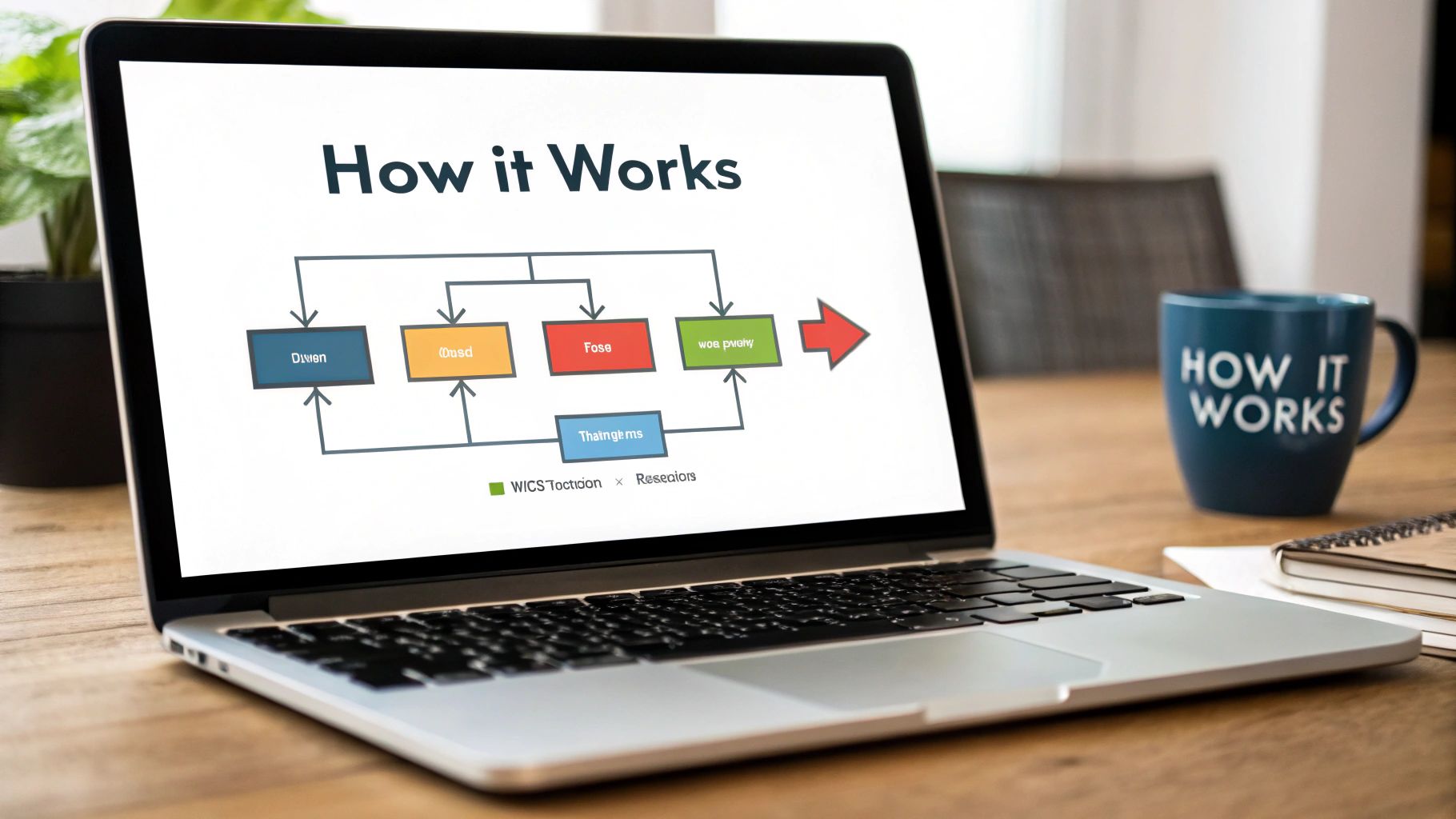
While the features of referral tracking software are impressive, they’re just tools in the toolbox. The real magic isn't just in the slick automation or the cool analytics—it's in the real, measurable business growth that comes from using them. When you finally move past those messy spreadsheets and endless manual follow-ups, you unlock growth that directly strengthens your bottom line.
Many companies use this technology to run their own successful affiliate programs, but the core advantages are universal. It’s all about transforming what was once a hit-or-miss channel into a predictable, steady stream of fantastic customers. This gets right to the heart of two of the most important metrics for any company trying to scale.
Lowering Customer Acquisition Cost (CAC)
Your Customer Acquisition Cost (CAC) is simply what you spend, on average, to land a new customer. A high CAC can drain resources and stall growth, even for a great business. Referral marketing, when done right with proper software, is one of the best ways to bring that number down because it runs on trust.
Think about it: a recommendation from a friend carries so much more weight than any paid ad ever could. That built-in trust means people convert faster and with less friction. You're not just paying for clicks or views; you're rewarding an actual, successful sale, which makes every marketing dollar work harder.
Boosting Customer Lifetime Value (CLV)
And the good news doesn’t end when you make the sale. Referred customers aren't just any new customers—they often become your best customers. They walk in the door with a foundation of trust already in place, which means they tend to be more loyal and stick around longer.
This loyalty leads directly to a higher Customer Lifetime Value (CLV). In fact, a major reason these tools are so popular in the North American market (which makes up nearly 35% of the global market share) is that referred customers have a 37% higher retention rate. This isn't just about getting one-time sales; it's about building a more profitable and stable customer base for the long haul.
From Spreadsheet Chaos to Strategic Clarity
Let’s look at a classic example: a small SaaS company. For years, they tried to manage their "referral program" with a shared spreadsheet. It was a complete mess—full of manual entries, forgotten payouts, and no real insight into what was actually working. They had a gut feeling that word-of-mouth was helping, but they couldn't prove its value or figure out how to grow it.
After they finally switched to a proper referral tracking software, the change was night and day.
Before: They wasted hours every month trying to connect new sign-ups to vague "I heard about you from a friend" comments. Payouts were late, and their biggest fans felt ignored.
After: A dashboard automatically showed them exactly who was driving new trials and sales. Rewards went out instantly, delighting their advocates. Best of all, they discovered that their CAC from referrals was a staggering 60% lower than what they were spending on paid ads.
This shift gave them the confidence to invest more into their referral program because they finally had the data to back it up. They stopped guessing and started making smart decisions based on clear, reliable numbers. For anyone wanting to build a similar engine for growth, our guide on https://refgrow.com/blog/customer-referral-programs is a perfect place to start. The right software provides the framework to put those ideas into practice, turning your happiest customers into your most powerful growth asset.
How to Choose the Right Referral Software
Picking the right referral software can feel like a huge decision, but it doesn't have to be overwhelming. The secret is to stop looking at shiny features and start by looking inward at your own business goals. After all, the perfect tool for a B2C e-commerce shop is going to be wildly different from what a B2B SaaS company needs.
Before you even open a single "features" page, get crystal clear on what you're trying to achieve. Are you gunning for more trial sign-ups? Do you need to boost paid conversions? Or are you hunting for high-value enterprise leads? Your answer dictates everything, from whether you offer one-sided rewards (just for the referrer) or double-sided rewards (for both the referrer and their friend).
Once you know what success looks like, you can shift from being a passive browser to an active evaluator. This simple change in mindset helps you find a system that truly fits your business, not the other way around.
Define Your Core Evaluation Criteria
To make a smart choice, you need a solid framework for comparing your options. It's easy to get distracted by flashy new features that you'll never actually use. Instead, stay focused on the fundamentals that will make or break your program's success down the road.
Here are the non-negotiable areas to dig into for any referral tracking software you're considering:
- Scalability: Ask yourself: can this software grow with us? A platform that’s great for your first 100 advocates needs to handle 10,000 without a crippling price hike or a nosedive in performance. Check the fine print on advocate, referral, and team member limits.
- Integration Capabilities: Your referral platform can't live on an island. It has to talk to the rest of your tech stack. Look for native, hassle-free integrations with your CRM (like Salesforce), payment gateway (like Stripe), and marketing automation tools. Bad integrations mean manual data entry and a messy, siloed view of your customers.
- Pricing Transparency: Hunt for clear, predictable pricing. Be on high alert for hidden fees, sneaky transaction commissions, or earning caps that punish you for doing well. The best platforms have straightforward plans that let you grow without worrying about surprise bills.
- Customer Support: When things go wrong (and sometimes they will), can you get a real person to help you? Investigate the provider's support. Do they offer live chat, email, or a dedicated account manager? Good support is priceless, especially during setup and when you need to troubleshoot an issue quickly.
With a clear checklist, you can systematically compare your options.
Here is a practical checklist to guide you through the evaluation process. Use it to ask the right questions and ensure you're covering all your bases before making a final decision.
Referral Software Selection Checklist
| Evaluation Criteria | Key Questions to Ask | Why It Matters |
|---|---|---|
| Program Goals Alignment | Does this software support the specific reward structures I need (e.g., double-sided, tiered, cash, credits)? | Your software must enable your strategy, not limit it. If you can't build the program you envision, it's the wrong tool. |
| Integration with Tech Stack | Are there pre-built integrations for my CRM, e-commerce platform, and payment processor? How complex is the API? | Seamless integration prevents data silos and automates manual work, saving you time and reducing errors. |
| Scalability & Performance | What are the limits on advocates, referrals, or revenue? Will the cost increase dramatically as my program grows? | You need a platform that can support your growth without breaking the bank or slowing down. |
| User Experience (Advocate) | Is the advocate dashboard intuitive? How easy is it for my customers to share their link and track rewards? | A clunky, confusing experience for your advocates will kill your program before it even gets started. Simplicity is key. |
| User Experience (Admin) | Is the admin dashboard easy to navigate? Can I find the data and reports I need without extensive training? | You and your team will be living in this dashboard. It should empower you to manage and optimize, not create frustration. |
| Pricing & Value | Is the pricing model transparent? Are there hidden fees or commissions on referred revenue? Does the price align with the value provided? | Clear pricing protects your ROI. Avoid surprises that can eat into your referral program's profitability. |
| Support & Partnership | What level of customer support is included (live chat, email, phone)? Do they provide strategic resources or an account manager? | Strong support and strategic guidance can be the difference between a program that launches and one that succeeds long-term. |
This checklist isn't just about ticking boxes; it's about finding a platform that feels like an extension of your team.
Look for a True Partnership
As referral marketing has become a go-to channel for growth, software providers have had to step up their game. It's no longer enough to just offer a tool. Market analyses show a clear trend toward platforms that offer deep integrations and are accessible to a wider range of businesses. You can find more details on these market shifts and see how they're influencing software development.
A great referral software provider acts more like a growth partner than a simple vendor. They should provide resources, best practices, and strategic guidance to help you not only launch your program but also optimize it for maximum impact over time.
This means looking beyond the list of features. Assess the company's real commitment to helping you succeed. Do they have a robust knowledge base, a blog full of actionable advice, or an active user community? These resources are often just as valuable as the software itself. They provide the roadmap you need to turn your loyal customers into your most powerful growth engine.
Ultimately, choosing the right partner is just as important as choosing the right product.
Integrating and Launching Your First Program
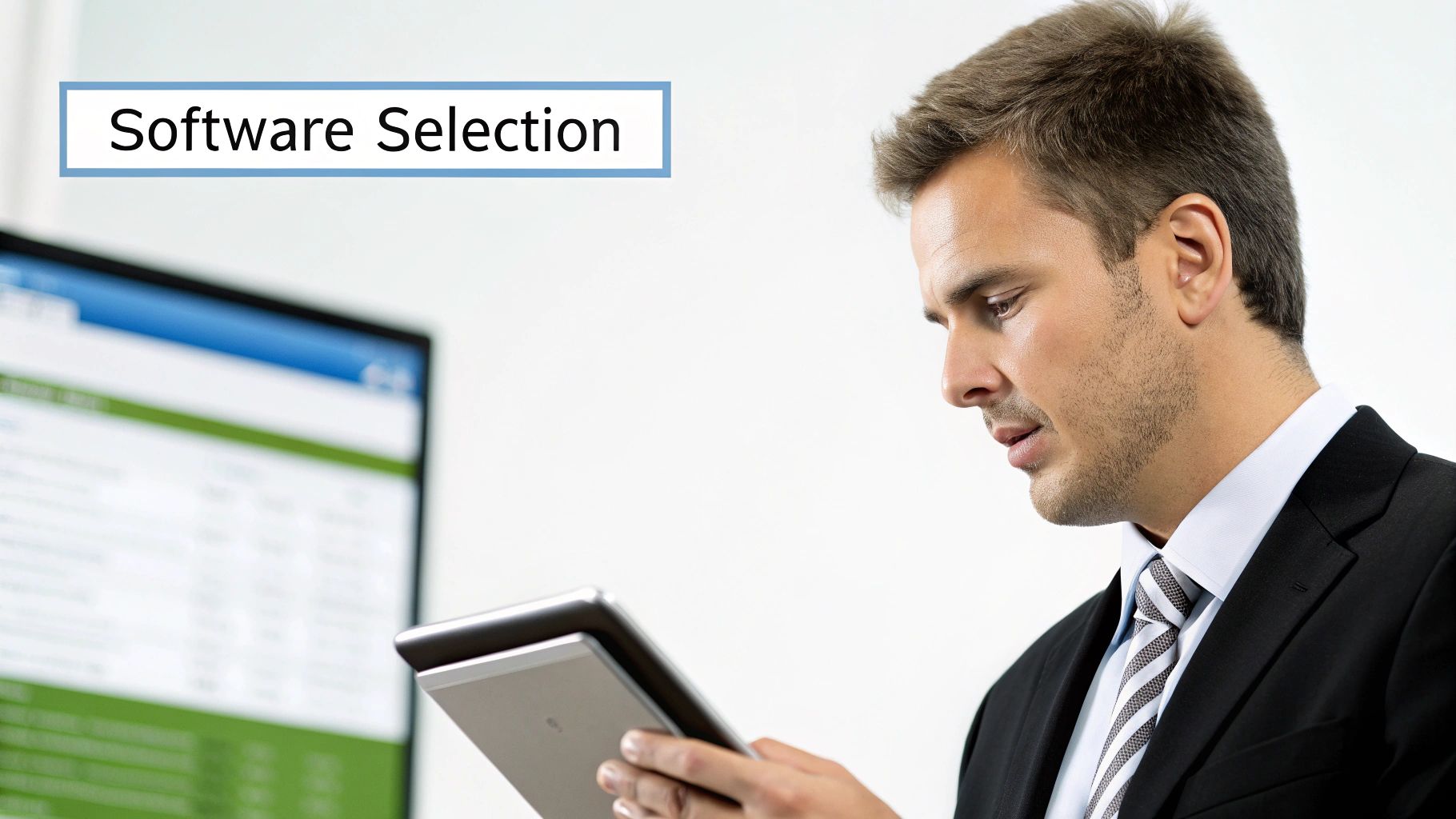
Alright, you've picked your referral tracking software. Now the fun begins. Launching your first program is where all that planning and strategy finally comes to life. This isn't just about flipping a switch; it's about carefully creating an experience that turns your best customers into enthusiastic advocates from the get-go.
A great launch doesn't happen by accident. It's a series of well-planned steps. If you break the process down, you can confidently move from the technical nuts and bolts to acquiring new customers through word-of-mouth.
Think of it like building a bridge. First, you pour the concrete foundation—the technical integration. Then you build the structure, making it attractive and strong enough to handle traffic. Finally, you cut the ribbon and put up signs to let everyone know it’s open for business.
H3: The Technical Setup and Integration
First things first: you need to connect your new software to your existing business tools. Thankfully, modern platforms have made this incredibly simple. Often, it only takes a few clicks to link up with e-commerce systems like Shopify or payment processors like Stripe. This connection is the central nervous system of your entire referral program.
This integration is what allows the software to "see" when a referred friend makes a purchase or signs up. It's the magic that makes the whole thing a "closed-loop process," where every referral is tracked and every reward is sent out automatically. No more manual spreadsheets.
For those who want more control, most platforms also offer an API. This hands your development team the keys to the kingdom, letting them build a completely custom, native experience. It's a bit more work, but the result is a program that feels like a core part of your product, not just a bolt-on.
H3: Designing Compelling Referral Offers
With the tech handled, it’s time to shift your focus to the human side of things. What's actually going to make someone tell their friends about you? The secret is a compelling, balanced offer. The programs I've seen succeed almost always use a double-sided incentive.
This simply means both the person doing the referring (your advocate) and their friend (the new customer) get something valuable. For instance:
- Your Advocate: Gets a $25 gift card for their successful referral.
- Their Friend: Gets 15% off their first order.
This creates a perfect win-win. The advocate feels generous for sharing a deal, and the new customer has a great reason to make that first purchase. For a deeper dive, our guide on building a referral program lays out some proven frameworks for crafting offers that truly connect with people.
The trick is to find the sweet spot: a reward that's valuable enough to get people talking, but sustainable for your business. Don't just copy what a competitor is doing. Think about what your customers would genuinely find useful—it could be store credit, a premium feature, or even cold, hard cash.
H3: Announcing Your Program and Driving Adoption
The program is built, the offer is killer—now you just need to tell everyone. A soft launch with a small group of your most loyal customers is a fantastic way to start. It lets you collect real-world feedback and smooth out any rough edges before the big public reveal.
Once you’re confident, it’s time to shout it from the rooftops. Create some simple promotional materials to get the word out.
- Email Campaigns: Send a dedicated email to your customer list announcing the new program and explaining how it works.
- In-App Banners: Use pop-ups or permanent banners on your website or inside your app to catch people's attention.
- Social Media Posts: Share the news on your social channels and encourage your followers to become your first advocates.
The goal is to make your program impossible to miss. From day one, keep a close eye on your software's dashboard. See which channels are driving sign-ups and which are leading to actual sales. This early data is gold—it’s your roadmap for optimizing the program for long-term growth.
The Future of Referral Tracking with AI
Referral tracking software is getting a whole lot smarter. We're moving past simple automation and stepping into an era of truly intelligent growth. Artificial Intelligence (AI) isn't just a buzzword anymore; it's genuinely changing how businesses run their word-of-mouth marketing, turning these platforms from passive record-keepers into proactive growth partners.
This means your software is about to do more than just tell you what happened last month. It will start predicting what's likely to happen next. Think of it as having a data scientist built right into your system, one that’s constantly sifting through customer behavior to pinpoint your best potential advocates—sometimes even before they've made a single referral.
From Reactive Data to Predictive Insights
So, how does this actually work? The next wave of referral platforms uses AI-powered predictive analytics. By looking at things like how often a customer buys, their satisfaction scores, and how they engage on social media, the software can flag individuals who have all the tell-tale signs of becoming a "super-advocate."
This is a game-changer. Instead of just waiting for people to find your referral program, you can proactively invite these high-potential customers with a personalized touch, dramatically increasing the odds they'll join and participate.
The goal is to move from a one-size-fits-all approach to a deeply personalized one. AI allows platforms to treat each advocate as an individual, figuring out what motivates them and tailoring the experience to get better results.
This AI-driven personalization isn't just theory; it's already delivering. Right now, about 68% of marketers are using AI tools to make their referral programs more effective. AI models can dynamically tweak reward offers, refine targeting, and adjust messaging to boost conversions. It ensures every dollar you invest is working as hard as it can. For a deeper dive into this trend, check out some recent market research.
Intelligent Optimization and Strategic Recommendations
Beyond finding the right people, AI is also revolutionizing how programs are managed day-to-day. Machine learning algorithms can analyze your performance data in real time and suggest smart adjustments.
For instance, an AI might notice that cash rewards are falling flat with a specific customer group, but store credits are knocking it out of the park. The platform could then recommend shifting your budget or even automatically change the default reward for that group to maximize your ROI. This creates a continuous optimization loop, keeping your program sharp and efficient without you having to constantly monitor it.
Getting a handle on this technology is becoming essential for building a growth plan that lasts. If you're looking to sharpen your own approach, our guide on creating a modern referral marketing strategy offers a solid framework for putting these advanced ideas into practice.
Ultimately, the future of referral tracking software is about partnership. Your platform will become more than just a tool for getting things done; it will act as a strategic advisor. It will serve up data-backed recommendations, automate complex decisions, and help you build a referral channel that's more powerful, predictable, and profitable. It’s all about turning raw data into intelligent action.
Frequently Asked Questions
Jumping into the world of referral marketing often brings up a few common questions. Let's walk through some of the most frequent ones I hear, covering everything from cost and timelines to whether this is even the right move for a smaller business.
How Much Does Referral Software Typically Cost?
The price tag for referral software can really run the gamut, which is good news because it means there's likely a plan that fits your budget. For startups or small businesses just dipping their toes in, you can find solid entry-level plans starting around $50-$100 per month.
As your company grows and needs more powerful features, you'll see plans ranging from $200 to over $500 per month. It's also pretty common for providers to charge a small commission on sales that come through referrals, usually somewhere between 1% and 5%. The key is to find a provider with transparent pricing—you don't want to get surprised by hidden fees or hit a ceiling that punishes you for being too successful.
How Long Until I See Results From My Program?
While there's no magic number, most businesses start seeing the first trickles of success within 30 to 90 days of launching. These early wins almost always come from your die-hard fans and loyal customers who are already eager to spread the word.
It's important to remember that a referral program is a marathon, not a sprint. It’s a long-term growth engine. Real, sustainable momentum tends to build over 3-6 months as word spreads and the friends of your advocates start becoming customers themselves.
If you want to get things moving faster, a big promotional push right out of the gate is a great idea. Hit your email list, post on social media, and use in-app notifications to let everyone know about the new program. That initial burst of awareness is what gets the flywheel turning.
Is This Software Suitable For Small Businesses?
Yes, one hundred percent. In fact, referral tracking software is one of the most powerful and cost-effective tools a small business can have in its marketing arsenal. It lets you tap into your greatest asset—your happy customers—to build trust and drive growth in a way that feels completely organic.
Think about it: instead of pouring money into expensive ad campaigns and hoping for the best, a referral program is performance-based. You only pay out a reward after you’ve made a sale. This makes it a wonderfully low-risk, high-reward channel. Modern software handles all the heavy lifting, so even a lean team can run a sophisticated program without getting buried in manual tracking and spreadsheets.
Ready to turn your happiest customers into your most effective sales team? Refgrow makes it simple to launch a fully native referral program directly inside your SaaS product with just one line of code. Start growing with Refgrow today.

